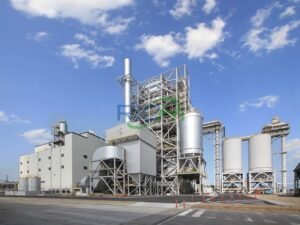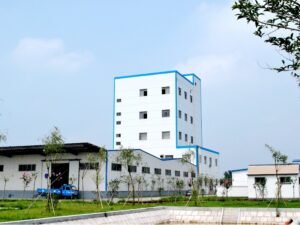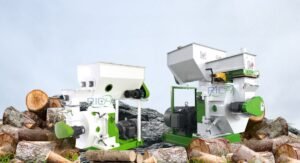
What is a Wood Pellet Production Line?
A wood pellet production line is a comprehensive system designed to convert raw wood materials into uniform wood pellets. These pellets serve as a renewable energy source, particularly for heating and power generation. The production line operates through a series of well-coordinated processes that involve several key components, each playing a crucial role in transforming timber residues into high-quality pellets.
The core function of a wood pellet production line is to process raw materials such as wood chips, sawdust, or wood shavings. The journey begins with the feedstock preparation, where the raw materials are reduced in size and dried to achieve the optimal moisture content. This initial stage is essential, as it significantly impacts the efficiency and quality of the final pellets. Following preparation, the materials are conveyed to a pellet mill, where they are subjected to high pressure and temperature. This process forces the wood fibers to bind together, forming dense pellets that can be easily transported and utilized.
Critical machinery involved in this production line includes wood chipper machines, hammer mills, dryers, pellet mills, and coolers. Each component is designed to handle specific tasks efficiently. For instance, the hammer mill plays a pivotal role in grinding materials into a fine powder, while the dryer is instrumental in achieving the desired moisture content, which is vital for pellet durability. As a whole, these elements collaborate to streamline the wood pellet production process, enhancing efficiency and ensuring the production of high-quality, energy-dense pellets.
In today’s renewable energy landscape, the significance of wood pellet production lines cannot be overstated. They not only contribute to the valorization of wood waste but also play a crucial role in promoting sustainable energy solutions to mitigate reliance on fossil fuels.
Benefits of Wood Pellet Production Lines
Wood pellet production lines offer a multitude of advantages that encompass both environmental and economic perspectives. One of the most significant environmental benefits is their role in reducing waste. By utilizing wood residues and by-products from forestry and woodworking industries, these production lines convert what would otherwise be discarded into a valuable energy source. This not only minimizes environmental pollution but also promotes the sustainable use of natural resources.
Moreover, wood pellets are a key component in supporting renewable energy initiatives. Their use in biomass energy systems contributes to reducing dependence on fossil fuels, fostering a greener future. As nations strive to meet stringent carbon reduction targets, the transition to energy sources like wood pellets becomes essential for achieving these goals. This shift towards renewable energy also reflects a rising consumer preference for eco-friendly options, thus enhancing market demand for wood pellet production lines.
From an economic standpoint, engaging in wood pellet production can lead to significant cost efficiency. The initial capital investment in a production line can be recouped through the savings generated by utilizing local biomass resources, rather than purchasing more expensive fossil fuels. Additionally, the profit potential associated with wood pellet sales can be enticing for manufacturers. The versatility of wood pellets extends across various industries, including heating and animal feed, thereby diversifying revenue streams. Companies involved in wood pellet production can cater to a broad market, providing opportunities to reach both domestic and international customers.
Ultimately, the holistic benefits offered by wood pellet production lines position them as a strategic choice for industries looking to embrace sustainable practices and enhance their economic viability. As the demand for renewable energy sources continues to grow, investing in wood pellet production will likely yield long-term advantages.
Why Choose a Wood Pellet Production Line?
In recent years, the growing emphasis on sustainable energy solutions has led to an increased demand for alternative energy sources. One effective solution that has emerged is the wood pellet production line. Businesses and startups considering entry into the renewable energy market can significantly benefit from implementing such a production line. Not only does it enhance operational efficiency, but it also aligns with global efforts toward sustainable energy practices.
The wood pellet production line enables manufacturers to convert biomass materials, primarily wood residues, into high-density pellets. This conversion process promotes waste reduction, as it utilizes by-products that would otherwise contribute to landfill waste. The result is a product that serves as a clean-burning alternative to fossil fuels, supporting environmental sustainability while tapping into a growing market. The ecological aspect of wood pellets is an essential factor for businesses aiming to improve their carbon footprints and appeal to environmentally conscious consumers.
Additionally, wood pellet production lines are designed for high productivity. They streamline the pellet manufacturing process, allowing companies to meet increasing market demands with improved output rates. Automated equipment, such as grinders, dryers, and pellet mills, work in harmony to ensure a consistent product quality, which not only attracts customers but also enhances reputation in a competitive marketplace.
Moreover, investing in a wood pellet production line can lead to a reliable profit stream. As energy costs rise and the demand for renewable energy sources expands, companies that produce wood pellets are well-positioned to capture growing market opportunities. Furthermore, the relatively low capital investment and operational costs associated with these production lines make it financially viable for startups and existing businesses to enter this lucrative sector.
Specific Processes in a Wood Pellet Production Line
The production of high-quality wood pellets involves several critical processes that ensure optimal output and consistency. This sequence typically includes raw material preparation, drying, grinding, pelletizing, cooling, and packaging. Each of these steps plays a pivotal role in the overall efficiency and quality of the final product.
The first step, raw material preparation, entails selecting suitable biomass sources such as sawdust, wood shavings, or other wood residues. This stage is crucial as the type of raw material significantly influences the quality of the wood pellets produced. The materials must be clean and free of contaminants to enhance combustion efficiency and reduce emissions in the final pellets.
Following preparation, the next step is drying. Moisture content in the raw materials impacts pellet formation and combustion properties significantly. A wood pellet production line typically incorporates drying equipment that reduces moisture levels to between 10% and 15%. Proper drying ensures that the wood fibers can bind effectively during the pelletizing process, maintaining pellet integrity.
Next, the dried biomass is subjected to grinding. This process reduces the size of the raw material to a uniform consistency, which is vital for ensuring even pellet formation. A well-designed wood pellet production line uses hammer mills or grinders to achieve this uniformity, allowing for optimal feed into the pellet mills.
Once the material is ground, the pelletizing phase follows. In this step, the prepared biomass is compressed and formed into pellets using high-pressure rollers and die plates. This stage is where the lignin in the wood acts as a natural binder, crucial for pellet durability.
After pelletizing, the newly formed pellets undergo cooling to stabilize and solidify their structure. Cooling also helps manage moisture levels and makes handling easier. Finally, the last step is packaging, where the pellets are stored in bulk or packaged for distribution. Each process in the wood pellet production line is interconnected, contributing significantly to the quality and efficiency of wood pellet production.
Choosing the Right Equipment for Your Production Line
Selecting the appropriate equipment for a wood pellet production line is essential to ensure efficiency and effectiveness in manufacturing. When evaluating machinery, several critical factors come into play, including production capacity, energy efficiency, and durability. Understanding these aspects will help you match equipment to your specific operational requirements.
First and foremost, consider the production capacity of the equipment. This measurement indicates how much raw material can be processed within a given time frame. If your operation demands high output, investing in larger machines with elevated throughput rates is advisable. However, for smaller-scale productions, compact models may prove sufficient, offering flexibility without the burden of excessive costs.
Energy efficiency is another vital element in the selection process. The wood pellet production line is energy-intensive, so opting for machinery with lower energy consumption can lead to significant long-term savings. Many advanced models now incorporate innovative technologies designed to reduce energy use while maintaining high production levels. Researching machinery that balances output with energy savings is crucial for both economic and environmental sustainability.
Durability of the equipment also plays a crucial role in operational longevity. A wood pellet production line that relies on robust machinery will experience fewer breakdowns, translating to reduced maintenance costs and improved overall productivity. Look for equipment constructed from high-quality materials and those that come with reputable warranties and service agreements. This investment can ultimately ensure the machinery can withstand the rigors of production.
Lastly, exploring modern technologies such as automation and continuous monitoring systems can enhance overall efficiency in your wood pellet production line. Automating certain processes can reduce labor costs while improving precision and consistency in production. When selecting equipment, consider how these technological advancements can integrate with your operational goals to optimize performance.
Common Challenges in Wood Pellet Production
Wood pellet production is a complex process that can be hindered by several challenges. One significant issue is the quality of raw materials. The effectiveness of the wood pellet production line largely depends on the characteristics of the raw materials used, such as moisture content, species, and density. Variability in these factors can lead to poor pellet quality, causing operational inefficiencies and potential machinery damage. To ensure consistency, manufacturers should implement rigorous quality control measures and invest in reliable suppliers who can provide uniform raw materials.
Another challenge faced by producers is the maintenance of machinery. The equipment used in a wood pellet production line requires regular maintenance to operate efficiently. Failure to adhere to proper maintenance schedules can lead to unexpected breakdowns, resulting in significant downtime and costly repairs. To mitigate such risks, operators should develop a proactive maintenance schedule that includes routine inspections, cleaning, and part replacements, enabling smoother and uninterrupted operations.
Market fluctuations also pose challenges to wood pellet manufacturers. The demand and pricing in the wood pellet market can be unpredictable, influenced by factors like renewable energy policies, competition from alternative fuels, and changes in consumer preferences. To navigate this volatility, producers should diversify their market approaches and develop strong relationships with buyers while also keeping abreast of market trends. By remaining adaptable, companies can adjust production levels and pricing strategies as needed, helping to maintain stability during uncertain times.
In conclusion, by understanding and addressing the common challenges in wood pellet production—specifically concerning raw material quality, machinery maintenance, and market fluctuations—manufacturers can enhance the efficiency and reliability of their wood pellet production line. Adopting best practices in these areas is essential for a successful operation and sustainable growth.
Market Trends and Future of Wood Pellets
The wood pellet market has witnessed robust growth in recent years, driven by an increasing emphasis on renewable energy sources and sustainable fuel alternatives. As concerns regarding climate change escalate, many countries are shifting toward cleaner energy solutions, with wood pellets emerging as a viable option for both heating and power generation. This transition is primarily influenced by global policies aimed at reducing carbon emissions and promoting renewable energy, thereby boosting the demand for wood pellet production lines.
Current market trends indicate a rising interest in biomass energy, particularly in Europe and North America, where there is a significant focus on reducing reliance on fossil fuels. The production of wood pellets has become an integral part of this shift, facilitating the establishment of a circular economy. The wood pellet production line plays a crucial role in this process, converting timber waste into high-quality pellets that serve as a carbon-neutral energy source. This not only contributes to environmental sustainability but also enhances energy security.
Looking ahead, the future of wood pellet production appears promising, thanks to ongoing innovations and advancements in technology. For instance, improvements in machinery design and efficiency are expected to increase the output of wood pellet production lines while minimizing energy consumption and waste. Additionally, the development of specialized pellets aimed at specific market segments, such as industrial applications or residential heating, presents new opportunities for producers.
In conclusion, the wood pellet market is poised for continued growth, fuelled by the global push for sustainability and energy diversification. As technologies evolve and production methodologies improve, the wood pellet production line will become ever more efficient and adaptable, aligning with future energy demands and environmental goals.
Why Choose Richi Machinery as Your Supplier?
Choosing the right supplier for a RICHI wood pellet line is crucial for ensuring the efficiency and longevity of the production process. Richi Machinery stands out as a leading choice in the industry, primarily due to its strong reputation for manufacturing high-quality machinery. The company has consistently delivered reliable equipment designed to meet the diverse needs of clients engaged in wood pellet production. With years of experience in the field, Richi Machinery has built a solid foundation of trust with its customers, which is reflected in numerous positive testimonials and case studies.
An integral aspect of Richi Machinery’s appeal is its commitment to exceptional customer service. The company provides thorough consultations to understand specific production requirements, facilitating a tailored approach to each project. This level of engagement not only simplifies the acquisition process but also helps clients select the most suitable machinery for their wood pellet production line, ensuring optimal performance. Furthermore, Richi Machinery’s team consists of industry experts who offer valuable insights and recommendations throughout the purchasing journey, enhancing client confidence in their decisions.
Richi Machinery also emphasizes customization options, allowing clients to create a wood pellet production line that aligns perfectly with their operational goals. This flexibility not only accommodates a variety of raw materials but also adapts to different production scales, providing a practical solution for businesses of any size. Additionally, after-sales support is a significant benefit of partnering with Richi Machinery. Their dedicated support team is readily available to assist with maintenance, troubleshooting, and any operations-related inquiries, ensuring that production lines run smoothly post-installation.
In summary, Richi Machinery’s blend of quality, personalized service, customization, and robust after-sales support makes it a prime supplier for companies looking to invest in a wood pellet production line. Their proven track record in the industry positions them as a reliable partner for businesses embarking on or expanding their pellet production capabilities. Case: wood pellet plant
Conclusion: The Future of Wood Pellet Production
In recent years, wood pellet production lines have gained increasing attention due to their significant role in the renewable energy sector. These production lines not only facilitate the efficient conversion of biomass into a sustainable energy source, but they also optimize operational efficiency and product consistency. As businesses continue to strive for more environmentally friendly practices, investing in a wood pellet production line proves to be pivotal for meeting energy needs while adhering to sustainability goals.
The processes involved in wood pellet production, from raw material selection to the final packaging of pellets, demonstrate how advanced technology can streamline production and reduce waste. By leveraging automation and top-tier machinery, manufacturers can improve productivity and ensure that the quality of the final product meets high industry standards. Additionally, the use of renewable resources not only bolsters supply chains but also minimizes carbon footprints, positively impacting the environment.
Furthermore, as global demand for clean energy sources rises, particularly in the wake of climate change, wood pellet production lines present a viable option for both industrial and residential energy solutions. This shift to biomass energy underscores the importance of investing in reliable and efficient production systems. As stakeholders in this sector seek to navigate evolving regulations and competitive markets, partnering with a reputable supplier for wood pellet production lines becomes ever more crucial.
Ultimately, embracing wood pellet technology not only supports business growth but also contributes to a more sustainable and resilient energy landscape. By remaining proactive in adopting these innovative production methods, companies can position themselves favorably within their industries while actively promoting environmental stewardship. The future of wood pellet production is bright, offering a pathway not just for energy production but for sustainable practices worldwide.






